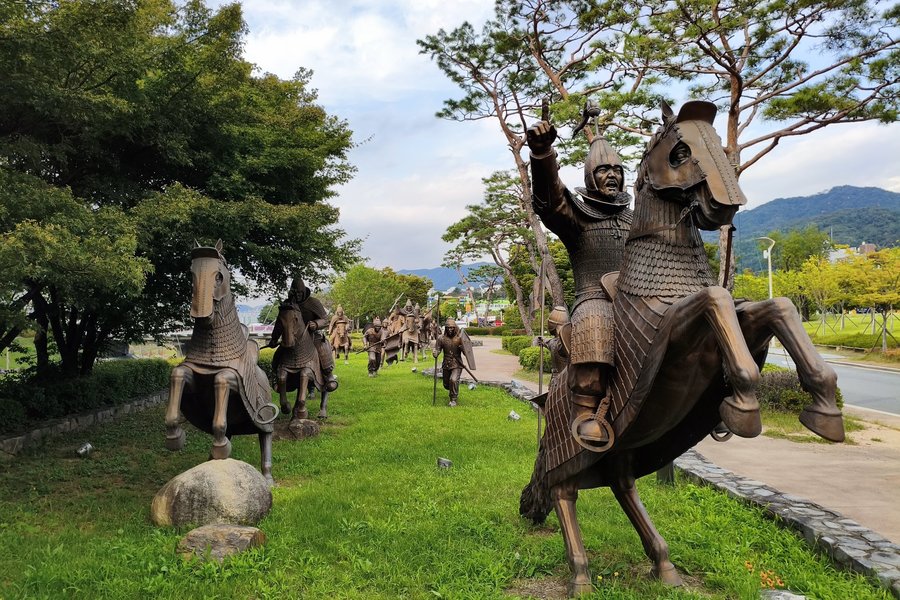
Time of the visit: the 30th of sept.,2025
I arrived at Gimhoe's light railway station" King Soro" from where I immediately went to the Royal tomb of king Soro.
I had expected a small tomb, but instead I found a whole complex of different buildings as well as two larger dolmens in the precinct.
The area consists of the tumulus,newly built buildings like the "Sung-an shrine" which houses the ancestral tablets of 8 kings and queens,older buildings like the ""Sungseon shrine"which keeps the ancestral tablets of the King Soro and Queen Heo or the "Anhyang-gak," which served as a temporary storage facility for candles and incense. There are probably around 15 buildings. One of these buildings houses various artifacts, another serves as an information center with a film screening (fairly insignificant).
Afterwards, I went to the tumuli in the so-called Daeseong-dong. On the way there, I passed the "Hanok Experience," which I briefly entered to take some photos of the hotel's beautiful traditional houses. I also passed the Gimhoe Folk Museum, which I briefly visited (free admission).
I climbed Aeguji Hill (Daeseong-dong tumuli) and walked from one information board to the next (all in Korean and English) until I came across a small exhibition hall containing two excavated tombs, realistically showing the burial methods and burial goods for members of the ruling class.
Then I went inside to the Archaeological Museum, which only deals with the local member of the Gaya confederacy in contrast to the National Museum, where the focus is more on the whole Gaya confederacy. The Gaya confederacy (42-562) and its member states were located in the southern regions of the korean peninsula.
Just this much: the museum is excellent and does a fantastic job didactically, in contrast to the National Museum, where much is only in korean and the information in english is poor, irrelevant, or simply meaningless.I can only advise anyone who has limited time to give priority to the Archaeological Museum, which works well and vividly with models and partially realistic imitations.
Then I went to the National Museum, where the receptionist told me in broken english that there was a children's museum on the ground floor and the Gaya section on the third floor. It didn't take me long to explore the museum... lots of artifacts, no common thread.
I left that building and entered the yard of the huge building next to the museum where I found a cafe and enjoyed a coffee. To my great surprise I learnt that that cafe was next to the exit of the National Museum which consists of two different locations.
It was already 5:30 p.m. I entered the museum through the back exit, so to speak. I looked at the third floor with its many artifacts and then went downstairs, where all the doors were closed. I was probably the only visitor. Luckily, an employee came through the locked doors. He left me alone on the second floor with 10 minutes to spare and closed the museum.
Both the Archeological museum and the National Museum are free.
Directly behind the museum is a beautiful hilltop park, on whose "summit "(Gujibong Peak), according to legend, King Soro hatched from an egg. From there, a direct path leads down to the tomb of Heo Hwang-ok, the queen consort of King Soro. The historic site consists of a tumulus, a small mini-pagoda, various historical buildings, and a small pagoda above the tumulus. I would recommend visiting this tomb last, as it is open until 8 p.m., unlike the museums and also unlike King Soro's tomb.
Last but not least, I walked around and on Aeguji Hill again... at night... fascinating. The Daenseong-dong tumuli far exceeded my expectations.
Addendum: Yesterday, oct. the 16th, 2025, I had the surprising opportunity to visit the Gaya Tumuli Yisandong in Goryeong. I had a little over three hours in Goryeong, where I was stopping on the way back from the Haeinsa Temple world heritage site via Daegu to Busan.
Goryeong has a small but interesting museum with very friendly staff.It reproduces the interior of Jisandong Tumulus nr.44 as it was at the time of the excavations.The tumulus nr.44 is the largest sacrificial burial royal tomb discovered in Korea so far. Directly in front of the museum is a medium-sized tomb. Next to the museum, two paths lead up to the many burial mounds... and "high" really means high. The view from tomb number 1 is spectacular; the entire area is dotted with burial mounds. At one of the mounds, you can even watch the archaeologists at work. The descent through the mounds is something special... you can even cross the road over a bridge to visit the second large mound complex. The Jisandong Ancient Tomb Site is as impressive as Gimhoe. Absolutely worth a visit!
More on
Comments
No comments yet.
